
HYDROSEEDING
ISO 9001:2005 Certified


Hydroseeding, also known as hydraulic mulch seeding or hydro-mulching, is a method used for seeding large areas with a mixture of seeds, water, and a mulch material. The mixture is applied using specialised equipment that sprays it onto the ground, creating a protective layer that helps retain moisture, promote germination, and establish vegetation.
Hydroseeding is commonly used in erosion control, land reclamation, and landscape restoration projects. The mulch material used in hydroseeding can vary, but often includes a combination of wood fibres, straw, or other biodegradable materials that provide stability and protect the seeds from erosion, harsh weather conditions, and predation.
Benefits of Hydroseeding:
We at Savinaya, ensure proper designing and overseeing hydroseeding applications to meet project requirements and environmental goals. Hydroseeding offers advantages such as fast and uniform coverage, cost-effectiveness, and the ability to seed difficult or inaccessible areas.
Rapid Germination and Growth
Hydroseeding uses a combination of seed, mulch, fertiliser, and water to promote fast germination and growth of vegetation.
Even Coverage
The hydroseeding process ensures even distribution of seed, mulch, fertiliser, and water, resulting in a uniform and consistent layer of growth.
Erosion Control
The mulch used in hydroseeding helps to control erosion by protecting the soil from wind and water erosion.
Environmentally Friendly
Hydroseeding is an environmentally friendly option because it uses fewer resources than traditional seeding methods, requires less watering, and reduces the use of pesticides and herbicides.
FAQ's
Hydroseeding is a planting process that involves spraying a slurry of seed, mulch, fertilizer, and water onto a prepared soil surface. The slurry is usually sprayed using a high-pressure hose or nozzle, and the process is often used for large-scale planting projects, such as landscaping, erosion control, and reclamation.
Hydroseeding is an efficient and cost-effective way to establish vegetation on large areas of land. The process helps to control erosion, improve soil fertility, and reduce the need for labor-intensive planting methods. It also allows for precise seed distribution and can be customized to the specific needs of the planting site. At Savinaya, we have the expertise to conduct Hydroseeding efficiently and at affordable prices.
We use a wide range of seeds can be used for hydroseeding, including grasses, wildflowers, shrubs, and trees. The type of seed used will depend on the specific goals of the planting project, such as erosion control, landscaping, or reforestation.
Several factors should be considered when planning a hydroseeding project, including the size and location of the planting site, the type of soil and terrain, the desired plant species, and the climate and weather conditions. Proper site preparation, such as soil testing and grading, is also essential for successful hydroseeding.
The time it takes for vegetation to establish after hydroseeding will depend on several factors, such as the type of seed used, the weather conditions, and the quality of soil preparation. In general, it can take anywhere from a few weeks to several months for the plants to become established and start to grow.
